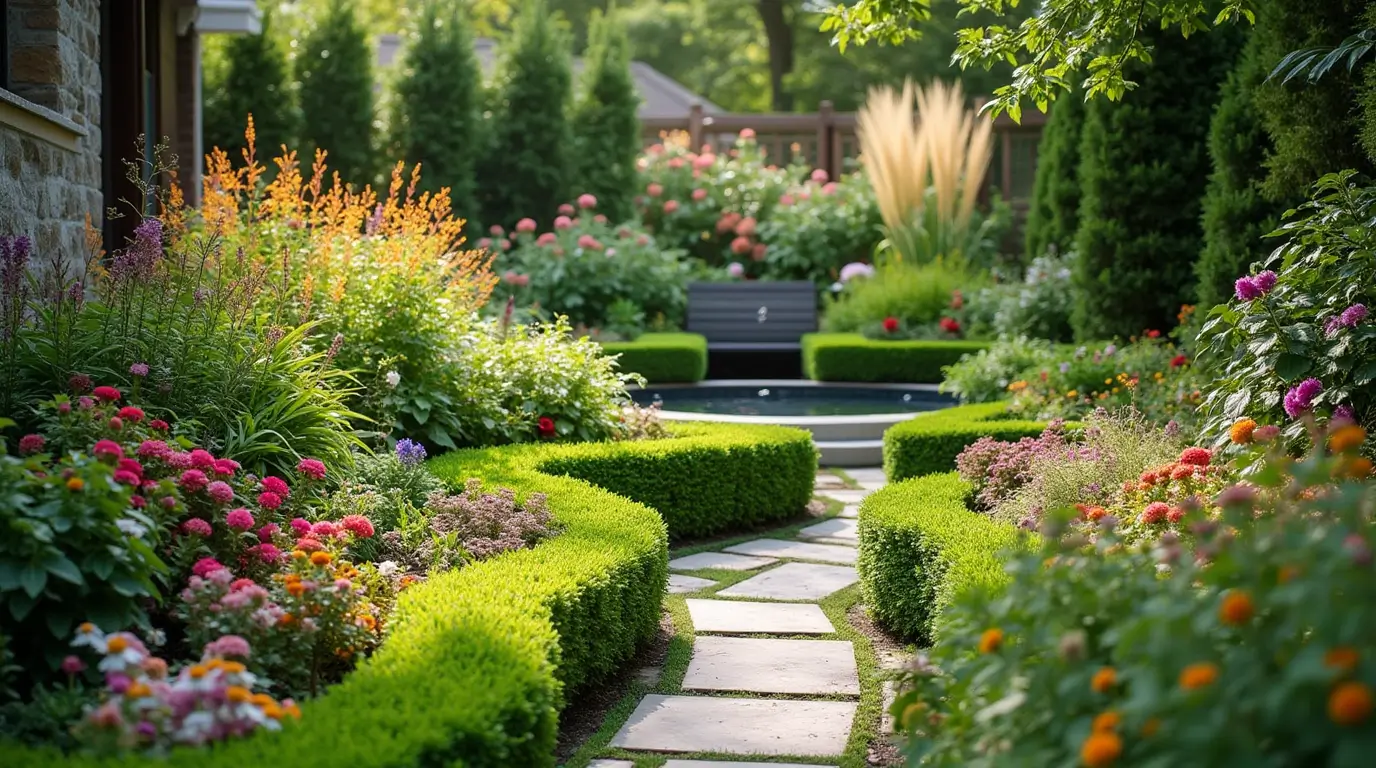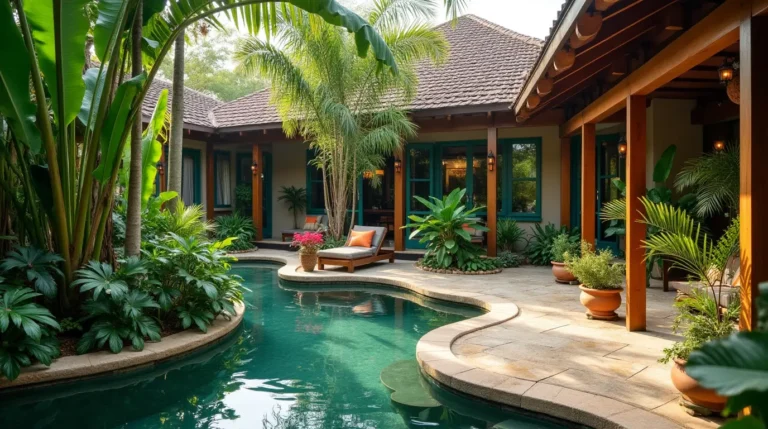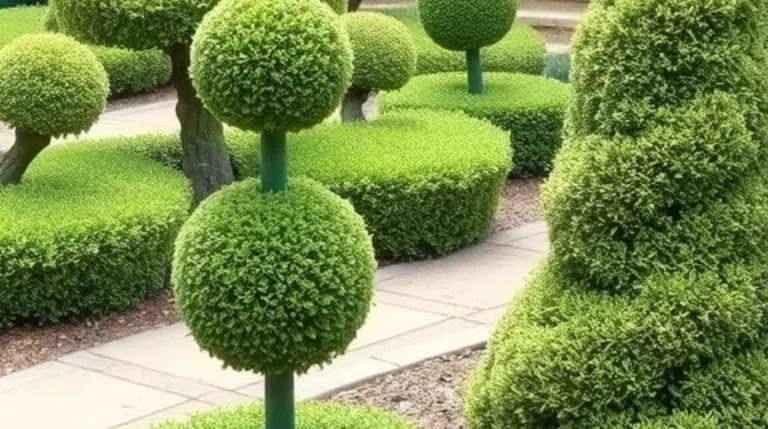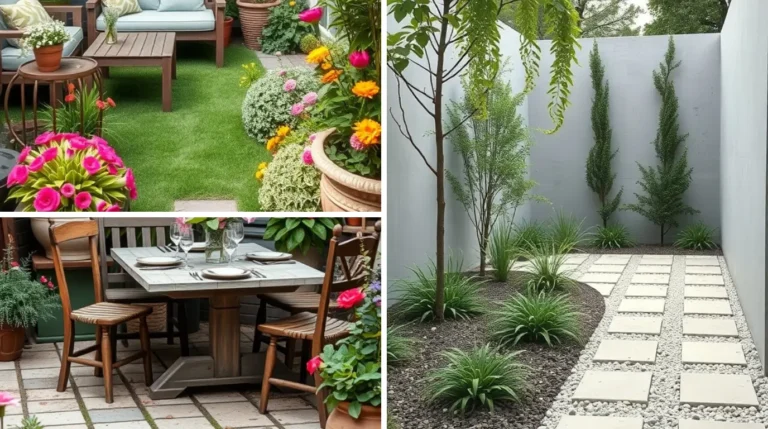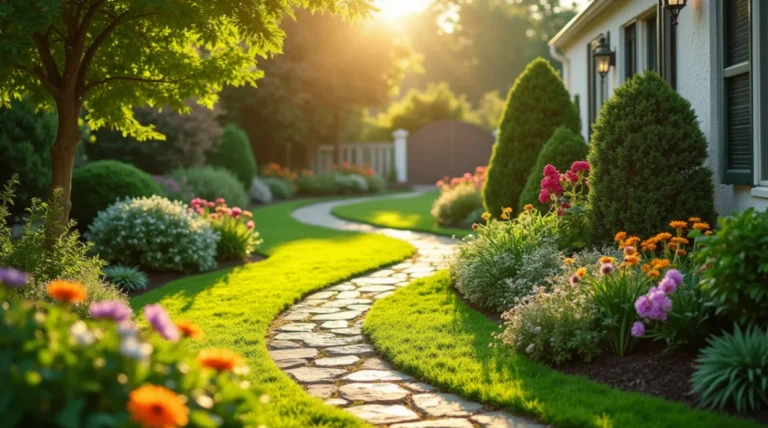Small Backyard Garden: How to Maximize Your Space
Turning a small outdoor area into a beautiful spot is a challenge many face. With a bit of creativity, even tiny spaces can become stunning compact garden designs.

A well-designed small backyard garden boosts your home’s look and offers a peaceful spot for relaxation and fun. By using smart space-saving ideas and landscaping tricks, you can make your space welcoming and full of life.
Key Takeaways
- Assess your outdoor space to determine its potential.
- Choose space-saving plants and landscaping features.
- Utilize vertical gardening to maximize space.
- Incorporate multi-functional garden elements.
- Consider the style and theme that suits your home.
The Potential of Your Small Backyard Garden
To make the most of your small backyard garden, you need to understand your space well. Knowing your available space and sun patterns helps you create a garden that thrives. It’s all about using your garden’s unique conditions to your advantage.
Assessing Your Available Space
Start by measuring and mapping your garden. This helps you see its size and layout. It’s the first step to making the most of your space.
Measuring and Mapping Your Garden Area
Use a tape measure to find your garden’s length and width. Then, draw a simple sketch or map. This will help you plan your garden design.
Identifying Existing Features to Work With
Look at any features in your garden, like trees or slopes. You can use these in your design or work around them.

Understanding Sun Patterns and Microclimates
Knowing how sunlight affects your garden is key. Sun patterns and microclimates greatly impact your garden’s health and productivity. Choose the right plants and design your layout wisely.
Tracking Sunlight Throughout the Day
Watch your garden at different times to see how sunlight falls. Note where it’s full sun, partial shade, or full shade.
Identifying Shade and Wind Patterns
Also, find out about any shade and wind patterns in your garden. Shade is good for cool-loving plants. Wind patterns can affect plant growth and comfort.
Planning Your Compact Garden Design
Creating a compact garden design means using your space wisely. It should also meet your needs and desires. A well-planned garden makes your outdoor space look better and serves as a place for relaxation and fun.
Setting Clear Garden Goals
First, decide what you want from your compact garden. It’s about finding a balance between beauty and function. Also, think about what you want the space to be used for.
Balancing Beauty and Functionality
A garden is more than just pretty. It should also be useful. Think about how you’ll use your garden, whether for meals, relaxation, or play.
Prioritizing Your Garden Wishes
Write down what you really want in your garden. This could be seating areas or specific plants. Knowing your top wishes helps guide your design.
Creating a Functional Layout
A good layout is key for a compact garden. It ensures the space is used well and safely.
Drawing Your Garden Plan to Scale
Begin by drawing a scale plan of your garden. This lets you see the space better and make better choices about where to put plants and other features.
Designing Traffic Flow in Limited Space
Think about how people will move through your garden. A well-thought-out path can make your garden feel bigger and more inviting.

Choosing a Garden Style That Maximizes Space
The garden style you choose affects how big your garden feels and how useful it is.
Modern Minimalist vs. Cottage Garden Approaches
Styles like modern minimalist or cottage gardens have their own benefits for small spaces. A minimalist garden can look bigger by avoiding clutter. A cottage garden can feel cozy and intimate.
Adapting Design Styles to Small Spaces
No matter the style, it’s important to adjust it for your space. This might mean picking smaller plants or using vertical gardening.
With careful planning, you can make a beautiful, useful outdoor space. It will meet your needs and make your home look better.
- Define your garden goals and priorities.
- Create a scale plan for your garden.
- Choose a garden style that complements your space.
Space-Saving Garden Solutions
Small gardens need creative ideas to make the most of every inch. It’s important to think outside the box when working with limited space.

Multi-Functional Garden Elements
Using multi-functional elements is key for small gardens. These items do more than one thing, cutting down on clutter and making the space more useful.
Benches with Built-in Storage
A bench with storage is a great example. It offers a place to sit and a secret spot for gardening tools or cushions.
Planters That Double as Boundaries
Planters that act as boundaries are another smart idea. They help divide the garden, add beauty, and provide more space for plants.
Optical Illusions to Make Gardens Appear Larger
Optical illusions can make small gardens seem bigger. Design tricks can make the space look larger than it is.
Using Mirrors Strategically
Using mirrors is a clever trick. A mirror opposite a window can reflect light and views, making the space seem bigger.
Creating Depth with Layered Plantings
Layered plantings add depth, making the garden feel larger. Mixing plants of different heights and textures adds interest and dimension.
Zoning Techniques for Small Spaces
Dividing a small garden into zones or “rooms” improves functionality. This can be done through various zoning methods.
Creating “Rooms” in Tiny Gardens
With furniture, planters, or other items, you can set up different areas. This could be a seating spot or a planting bed.
Defining Areas Without Walls
You can also define areas without walls. Changing paving materials or placing plants strategically can mark different zones.
Vertical Gardening Strategies
Adding vertical elements to your garden can make it look better and work better. It’s great for small backyards where space is tight. You can use walls, trellises, and other vertical spots to make a lush garden that uses every inch of space.
Wall-Mounted Planters and Living Walls
Wall-mounted planters and living walls are perfect for adding greenery without taking up floor space. You can grow herbs, succulents, flowers, and even veggies on them.
DIY Pallet Gardens
Repurpose an old pallet to make a wall-mounted planter. Attach it to a wall and add pots for a unique garden feature. It’s a cheap and eco-friendly way to beautify your garden.
Modular Living Wall Systems
For a sleek look, try modular living wall systems. They’re panels that fit together on a wall, offering a modern look. They’re also flexible, letting you mix plants and designs.

Trellises and Arbors for Climbing Plants
Trellises and arbors are classic ways to support climbing plants. They provide shade and add beauty to your garden.
Building Space-Efficient Support Structures
Choose a trellis that fits the size of your plants. Make sure it’s strong and gets enough sunlight.
Best Climbing Plants for Small Gardens
Clematis, roses, and grapevines are great for small gardens. They’re easy to care for and look beautiful.
Hanging Gardens and Suspended Planters
Hanging gardens and planters add depth to your garden. They can be hung from a structure or a tree, making your garden more interesting.
Creating Overhead Interest
Hanging planters draw your eye up, making your garden seem bigger. Use plants that trail or flower to get the most impact.
Balancing Weight and Maintenance Needs
Make sure hanging planters don’t overload the structure. Regular care, like watering and pruning, keeps your garden looking good.
| Vertical Gardening Method | Best For | Maintenance Needs |
|---|---|---|
| Wall-Mounted Planters | Herbs, Succulents, Flowering Plants | Regular Watering, Occasional Pruning |
| Trellises and Arbors | Climbing Plants like Clematis and Roses | Initial Setup, Occasional Pruning |
| Hanging Gardens | Trailing Plants, Flowering Plants | Regular Watering, Frequent Pruning |
Container Gardening for Small Backyards
In small backyards, using containers can make a big difference. It turns even tiny spaces into lively gardens. Container gardening is flexible and can change any small area into a colorful spot.

Selecting the Right Containers
Picking the right containers is key to a successful garden. Think about the size and material of the containers.
Size and Material Considerations
Containers vary in size and material, like plastic, clay, wood, or metal. Big containers support deep roots, while small ones are great for herbs or succulents. The material also affects how long the container lasts and how it keeps temperature.
Drainage and Insulation Needs
Good drainage stops soil from getting too wet. Make sure containers have holes for water to drain. Keeping plants warm or cool is also important, especially for sensitive ones.
Strategic Container Placement
Where you put containers matters a lot. It affects how your garden looks and how well plants grow. Adding levels and layers makes your garden more interesting.
Creating Levels and Layers
Using different-sized containers makes your garden look deeper. You can use tiered planters or stack smaller ones on bigger ones.
Movable Gardens for Changing Conditions
Container gardening lets you move plants around. This is great for changing sunlight or weather. It helps plants grow better.
Maintaining Healthy Container Plants
Keeping plants healthy in containers is important. You need to water and fertilize them right.
Specialized Watering Techniques
Container plants dry out quickly. They need more water than ground plants. But, too much water is bad. Check the soil often to water just right.
Fertilizing in Limited Soil Volumes
Since there’s less soil, plants need fertilizers to get nutrients. A balanced fertilizer helps them grow and bloom well.
By choosing the right containers, placing them well, and caring for them, you can have a beautiful garden in even the smallest backyard.
Creating a Productive Backyard Vegetable Garden
To make a small backyard garden productive, pick the right plants and methods. Even with little space, you can get a lot of food. Use smart gardening tricks and space-saving ideas.
Space-Efficient Vegetable Varieties
Picking the right plants is key for a small garden. Dwarf and compact varieties grow well in tight spots. They taste and are as nutritious as bigger plants.
Dwarf and Compact Varieties
Dwarf tomatoes, cucumbers, and squash are great for small gardens. They need less room and can use cages or trellises for support.
High-Yield Plants for Small Spaces
Some plants are better at producing more food in less space. ‘Patio’ tomatoes and ‘Bush Pickle’ cucumbers are made for small gardens. They grow compactly but produce a lot.
Succession Planting Techniques
Succession planting means planting seeds in batches every few weeks. This keeps your garden full of food all season. It’s a smart way to use space.
Planning Your Planting Calendar
Start a planting calendar to plan your succession planting. Note when to plant each batch. Think about how long each plant takes to grow.
Quick-Growing Crops Between Main Harvests
Fast-growing crops like radishes, lettuce, and spinach are perfect for filling gaps. They use space well and keep your garden busy.
Companion Planting in Limited Spaces
Companion planting pairs plants to help them grow better and fight pests. It’s especially helpful in small gardens.
Plant Combinations That Save Space
Some plant pairs save space and boost growth. Marigolds with tomatoes fight nematodes, while basil keeps pests away from tomatoes.
Integrating Herbs with Vegetables
Herbs like basil, mint, and cilantro add flavor and aroma to vegetables. They also keep pests away and attract good bugs.
Small Yard Flower Beds That Make an Impact
Creating a stunning flower bed in a small yard is all about picking the right plants and designing with care. Even with little space, you can make a big impact that beautifies your outdoor area.
Choosing High-Impact Flowering Plants
The secret to a lively flower bed is picking plants that bloom long and need little care. Long-blooming varieties are key as they keep your garden colorful all season.
Long-Blooming Varieties
Plants like Black-eyed Susans and Daylilies are great for small yards. They bloom for a long time and come in many colors, fitting any garden style.
Strategic Color Planning
Planning your colors carefully can make your flower bed pop. Mixing colors that go well together adds interest and makes the space look bigger.
| Plant | Bloom Duration | Color |
|---|---|---|
| Black-eyed Susans | June to September | Yellow |
| Daylilies | July to August | Varied |
| Lavender | June to August | Purple |
Layering Techniques for Small Flower Beds
Layering plants is key for adding depth and interest in small flower beds. Mixing plants of different heights and textures makes your garden lively and engaging.
Creating Depth with Foreground and Background Plants
Using both foreground and background plants adds depth to your flower bed. Taller plants like shrubs or grasses make a great backdrop. Smaller plants and flowers fill in the front.
Seasonal Succession Planning
Planning for seasonal changes keeps your flower bed interesting all year. Choosing plants that bloom at different times keeps your garden dynamic.
Tiny Backyard Landscaping Principles
Effective tiny backyard landscaping turns small spaces into beautiful retreats. By using key principles, homeowners can make their outdoor areas both pretty and useful, even with little space.
Creating Focal Points
Focal points catch the eye and add interest to a garden. In small backyards, they’re key to hiding the space’s size.
Statement Plants for Small Spaces
Choosing statement plants with bold leaves or bright flowers makes a big impact. Plants like Hydrangea or Boxwood are great for their striking looks.
Artistic Elements as Centerpieces
Art pieces or water features can be the garden’s heart. They bring personality and depth to the space.
Incorporating Hardscaping Elements
Hardscaping, like paving and edges, shapes the garden’s look and function. It’s crucial for a well-designed space.
Space-Efficient Paving Patterns
Patterns like herringbone or running bond make the garden look better. They help the space feel connected and flowing.
Using Boundaries and Edges Effectively
Boundaries and edges define the garden’s areas. Edging with brick, stone, or metal adds texture and interest.
Using Color and Texture
Color and texture are key to a beautiful garden. Choosing the right plants and materials can make a small backyard stunning.
Color Schemes That Expand Space
Light colors can make a small garden seem bigger. Using soft colors for plants, paving, and furniture opens up the space.
Textural Contrasts in Compact Gardens
Using different textures adds depth to the garden. Mixing smooth and rough elements creates visual interest.
| Element | Description | Benefit |
|---|---|---|
| Statement Plants | Plants with striking foliage or blooms | Create focal points |
| Artistic Elements | Sculptures, water features | Add personality, create depth |
| Paving Patterns | Herringbone, running bond | Enhance visual appeal, create flow |
Urban Gardening Ideas for Limited Spaces
Urban dwellers can make small outdoor spaces bloom with creativity. Gardening in the city is more than making your area look good. It’s about making a green, peaceful spot in the city’s noise.
Balcony and Patio Transformations
Turning balconies or patios into gardens can boost your space’s look and use. Here are some tips to start:
- Use wall-mounted planters or trellises to make the most of vertical space.
- Pick small or dwarf plants that do well in pots.
Converting Concrete to Green Space
Even the most concrete-heavy patios can become green spots. Think about using big planters or a living wall to cover hard surfaces.
Railing Planters and Boundary Gardens
Railing planters are great for adding greenery without using floor space. They also help mark your balcony or patio’s edge.
Creating Privacy in Exposed Urban Gardens
Urban gardens often face the challenge of being open and lacking privacy. Here are ways to make your garden feel more private:
- Use living screens or barriers to block off views.
- Choose plants that meet both privacy and light needs.
Living Screens and Barriers
Living screens, like tall plants or shrubs, can block views from neighbors or passersby. This makes your garden feel more private and cozy.
Balancing Privacy with Light Needs
It’s key to find a balance between privacy and enough light for your garden. Pick plants that screen well but don’t block too much light.
Furniture and Accessories for Small Gardens
Small backyard gardens need creative furniture and decor to make the most of space. The right choices can turn a small garden into a cozy, functional outdoor area.
Space-Saving Furniture Solutions
Choosing furniture that does more than one thing is key for small gardens. Look for pieces that can be stored away when not in use.
Foldable and Stackable Options
Foldable chairs and tables, along with stackable stools, are great for small gardens. They save space and can be tucked away when not needed. Opt for durable materials like recycled plastic or wood from sustainable sources.
Built-in Seating Opportunities
Built-in seating, like benches around trees or along borders, saves space and blends well with the garden. Using space-saving garden solutions like these boosts both looks and function.
Dual-Purpose Garden Accessories
Accessories are also vital in making small gardens beautiful and functional.
Decorative Elements That Serve Functions
Decorative planters that also store things or garden ornaments that feed birds or keep pests away add charm. They keep the garden both beautiful and useful.
Storage Solutions That Enhance Design
Storage boxes or sheds that match the garden’s look keep it tidy. Choose designs that use natural materials or match the garden’s colors.
By using these space-saving garden solutions in your small backyard garden, you can make a lovely, useful, and welcoming outdoor space.
Lighting Your Small Backyard Garden
Proper lighting can turn your small backyard garden into a magical oasis at night. It makes your garden look better, keeps it safe, and lets you enjoy it longer.
Strategic Lighting Placement
Putting lights in the right places can make your garden look and feel better. It’s about picking out the things you want to show off and the areas that need light for safety.
Highlighting Garden Features
Light up your garden’s best parts, like plants, water features, or sculptures. Accent lighting can make these features pop at night.
Creating Nighttime Depth
Using different kinds of lights can add depth to your garden at night. Mix pathway lights, uplights, and string lights for a lively outdoor space.
Energy-Efficient Lighting Options
Nowadays, people are choosing lights that save energy for their gardens. These options are good for the planet and your wallet.
Solar Lighting for Small Gardens
Solar lights are perfect for small gardens. They’re easy to set up, need little care, and are green.
LED Systems for Targeted Illumination
LED lights shine bright and use less energy. They’re great for lighting up specific spots or paths, making your garden safer and more visible.
Maintenance Tips for Small Backyard Gardens
To keep your compact garden thriving, it’s essential to adopt effective maintenance strategies. A well-designed compact garden design not only looks appealing but also requires regular upkeep to maximize its potential.
Efficient Watering Systems
Efficient watering is crucial for a thriving backyard vegetable garden. Proper watering techniques ensure that plants receive the right amount of moisture without wasting water.
Drip Irrigation for Tight Spaces
Drip irrigation systems are ideal for small gardens as they deliver water directly to the roots of plants, minimizing evaporation and runoff. This method is particularly effective in compact garden design where space is limited.
Rainwater Harvesting on a Small Scale
Collecting rainwater in barrels or tanks is a simple and effective way to conserve water for your garden. This eco-friendly practice reduces your water bill and provides a natural source of water for your plants.
Streamlined Pruning and Upkeep
Regular pruning and upkeep are vital to maintaining the health and appearance of your garden. By adopting a routine maintenance schedule, you can prevent overgrowth and keep your garden looking its best.
Regular Maintenance Schedule
Establishing a regular maintenance schedule helps in keeping track of tasks such as pruning, weeding, and fertilizing. This ensures that your garden remains healthy and continues to thrive throughout the seasons.
Tools Designed for Small Gardens
Using the right tools can make a significant difference in garden maintenance. Opt for compact, multi-functional tools that are designed for small gardens, making tasks easier and more efficient.
Conclusion
Turn your small backyard into a vibrant oasis by following these steps. First, assess your space and plan a compact garden design. Use space-saving solutions to make the most of your area.
Incorporate vertical and container gardening to add depth and beauty. These methods can enhance your patio garden ideas. They help you make the most of your space.
Use multi-functional garden elements and optical illusions to make your garden look bigger. Zoning techniques also help. Choose the right containers and keep your plants healthy.
Creating a productive backyard vegetable garden is key. These tips will help you maximize your small backyard garden’s potential.
With these patio garden ideas and techniques, you can create a beautiful and functional outdoor space. Start transforming your small backyard garden today. Apply the strategies outlined in this article.
FAQ
What are some effective ways to maximize space in a small backyard garden?
To make the most of your space, think about vertical gardening. Use wall-mounted planters or trellises. Choose compact plants too. Also, add multi-functional garden elements like benches with storage to save space.
How do I assess the potential of my small backyard garden?
Start by measuring and mapping your garden. Look at what’s already there and the sun patterns. This helps you design a beautiful and useful garden.
What are some space-saving garden solutions for small backyards?
Use mirrors to make your garden look bigger. Create zones in your garden to organize it. Container gardening is also great for small spaces because it’s flexible.
How can I create a productive backyard vegetable garden in a small space?
Choose plants that don’t take up much space. Use techniques like succession planting to get more from your garden. Planting companions can also help your garden grow better and fight pests.
What are some tips for maintaining a small backyard garden?
Use efficient watering systems like drip irrigation. Keep your garden tidy with regular pruning and maintenance. This keeps your garden healthy and looking good.
How can I make my small yard flower bed more impactful?
Choose plants that bloom for a long time. Use layering to add depth. Plan your colors carefully to make your flower bed stand out.
What are some urban gardening ideas for limited spaces?
Turn balconies and patios into gardens. Use planters on railings and boundary gardens to save space. Privacy screens can also help define your garden area.
How can I choose the right furniture and accessories for my small garden?
Look for furniture that folds or stacks. Choose accessories that do more than one thing, like decorative items with storage.
What are some energy-efficient lighting options for small backyard gardens?
Use solar lights and LEDs to light up your garden. They highlight features and add ambiance at night. Place lights carefully to enhance your garden’s look.

